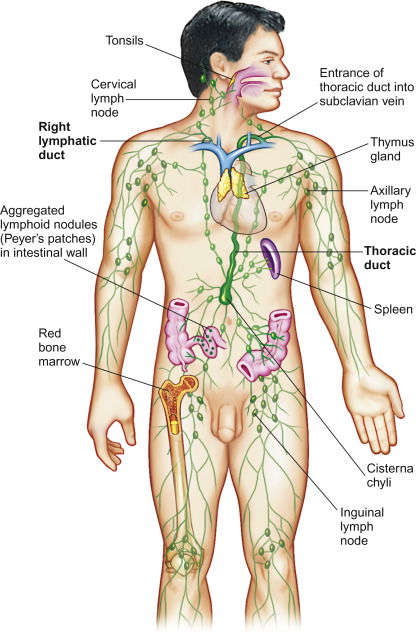Unlocking the Healing Potential: The Role of the Lymphatic System in Chronic Pain and Disease Recovery

The human body is a marvel of complexity, with interconnected systems working tirelessly to maintain balance and health. Among these systems, the lymphatic system often remains in the shadows, overshadowed by its more renowned counterpart, the circulatory system.
However, understanding the profound role of the lymphatic system is essential, particularly in the context of healing and recovery from chronic issues. This often-overlooked network of vessels and organs plays a crucial role in maintaining tissue fluid balance, immune function, and detoxification.

In recent years, researchers have shed light on its significance in addressing chronic health issues, offering new insights into how we approach healing and recovery.
The Anatomy and Function of the Lymphatic System:
The lymphatic system is a network of vessels, nodes, and organs distributed throughout the body, parallel to the circulatory system. It comprises lymphatic vessels, lymph nodes, the spleen, thymus, and tonsils, among other structures.
The primary function of the lymphatic system is to transport lymph, a clear fluid containing white blood cells, proteins, and cellular waste, from the interstitial spaces of tissues back into the bloodstream. This process helps maintain fluid balance, facilitates immune responses, and aids in the removal of toxins and waste products from the body.

Contributions to Healing and Recovery from Chronic Issues:
The lymphatic system's role in healing and recovery from chronic issues is multifaceted and profound. Here are some key contributions:
- Immune Function: Lymph nodes act as filtering stations where immune cells, such as lymphocytes and macrophages, monitor lymph for pathogens, toxins, and abnormal cells. By detecting and neutralizing these threats, the lymphatic system bolsters the body's immune response, crucial for combating chronic infections and inflammatory conditions.
- Fluid Balance: Edema, or swelling due to fluid retention, is a common feature of many chronic health issues, such as lymphedema, chronic venous insufficiency, and inflammatory conditions. The lymphatic system plays a crucial role in regulating fluid balance by absorbing excess interstitial fluid and returning it to the bloodstream. Proper lymphatic drainage reduces swelling, improves tissue oxygenation, and facilitates the delivery of nutrients to cells, promoting tissue repair and regeneration.
- Detoxification: In addition to its role in immune function and fluid balance, the lymphatic system serves as a vital component of the body's detoxification pathways. Lymphatic vessels transport metabolic waste products, toxins, and cellular debris away from tissues, preventing their accumulation and promoting their elimination through excretion organs such as the kidneys and liver. Enhancing lymphatic circulation supports the body's natural detoxification processes, which is essential for individuals with chronic issues related to toxin exposure or impaired detoxification pathways.
- Inflammation Management: Chronic inflammation underlies many health conditions, including autoimmune disorders, cardiovascular disease, and metabolic syndrome. The lymphatic system helps regulate inflammation by removing inflammatory mediators and immune cells from tissues, thereby preventing excessive tissue damage and promoting resolution of inflammation. Improving lymphatic flow through manual therapies, exercise, and lifestyle interventions can mitigate chronic inflammation, supporting overall healing and recovery.
- Nutrient Transport: The lymphatic system not only removes waste products but also facilitates the transport of dietary fats and fat-soluble vitamins absorbed from the digestive tract. These nutrients are packaged into chylomicrons and transported via lymphatic vessels, eventually reaching the bloodstream for distribution to cells throughout the body. Optimal lymphatic function is thus essential for nutrient delivery to tissues, supporting metabolic processes vital for healing and recovery.
Conclusion: The lymphatic system, often overshadowed by its circulatory counterpart, plays a critical role in healing and recovery from chronic issues. Its functions extend beyond fluid balance and immune response to encompass detoxification, inflammation management, and nutrient transport. Understanding the integral role of the lymphatic system offers new avenues for therapeutic interventions aimed at addressing chronic health issues. By supporting lymphatic function through lifestyle modifications, targeted therapies, and holistic approaches, individuals can harness the healing potential of this often-overlooked system, paving the way for improved health and well-being.
Fortunately, there are various tools and techniques individuals can employ to promote lymphatic circulation, reduce inflammation, and support detoxification. By integrating these strategies into daily life, individuals can harness the healing potential of their lymphatic system to facilitate recovery from chronic health issues.Tools to Stimulate the Lymphatic System:
- Manual Lymphatic Drainage (MLD): MLD is a gentle massage technique specifically designed to stimulate lymphatic flow. Trained therapists use light, rhythmic strokes to encourage lymph movement towards lymph nodes, promoting drainage and detoxification. Self-administered MLD techniques, such as gentle stroking or tapping motions along lymphatic pathways, can also be effective in supporting lymphatic circulation.
- Dry Brushing: Dry brushing involves using a natural-bristle brush to gently massage the skin in circular motions, starting from the extremities and moving towards the heart. This technique exfoliates the skin, stimulates blood flow, and encourages lymphatic drainage by stimulating the movement of lymph towards lymph nodes. Dry brushing is best done before showering, ideally once daily.
- Exercise: Physical activity plays a crucial role in promoting lymphatic circulation. Activities such as walking, jogging, swimming, and yoga help contract muscles, creating a pumping action that facilitates lymphatic flow. Incorporating both aerobic and resistance exercises into your routine can effectively stimulate the lymphatic system and support overall health.
- Hydration: Adequate hydration is essential for maintaining lymphatic function. Drinking plenty of water helps ensure optimal fluid balance and supports the transport of nutrients and waste products through the lymphatic system. Aim to drink at least 8-10 glasses of water per day, and consider incorporating hydrating foods such as fruits and vegetables into your diet.
- Healthy Diet: A diet rich in fruits, vegetables, lean proteins, and healthy fats supports lymphatic function and overall health. Avoiding processed foods, excessive salt, and sugar can help reduce inflammation and support detoxification pathways. Incorporate foods known to promote lymphatic health, such as citrus fruits, leafy greens, ginger, and turmeric, into your meals.
- Deep Breathing and Relaxation Techniques: Stress can impair lymphatic function by constricting lymphatic vessels. Practicing deep breathing exercises, meditation, and other relaxation techniques can help reduce stress levels and promote lymphatic circulation. Focus on diaphragmatic breathing, inhaling deeply through your nose and exhaling fully through your mouth, to enhance lymphatic flow.
- Compression Garments: Compression garments, such as compression socks or sleeves, apply gentle pressure to the limbs, promoting the movement of lymphatic fluid towards lymph nodes. These garments can be particularly beneficial for individuals with lymphedema or chronic venous insufficiency, helping reduce swelling and discomfort.
- Cupping Therapy: Cups not only the facilitate the lymphatic clearing of localized tissue but also enhance the natural drainage process (flushing of lactic acid, heat, and old blood). Cups releases previously obstructed area of drainage and improves circulation.